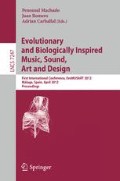Abstract
This study uses Genetic Programming (GP) in developing a classifier to distinguish between five musical instruments. Using only simple arithmetic and boolean operators with 95 features as terminals, a program is developed that can classify 300 unseen samples with an accuracy of 94%. The experiment is then run again using only 14 of the most often chosen features. Limiting the features in this way raised the best classification to 94.3% and the average accuracy from 68.2% to 75.67%. This demonstrates that not only can GP be used to create a classifier but it can be used to determine the best features to choose for accurate musical instrument classification, giving an insight into timbre.
Access this chapter
Tax calculation will be finalised at checkout
Purchases are for personal use only
Preview
Unable to display preview. Download preview PDF.
References
ANSI: American National Standard-Psychoacoustical Terminology. American National Standards Institute, New York (1973)
Brown, J.: Computer identification of musical instruments using pattern recognition with cepstra coefficients as features. Journal of Acoustical Society of America 105(3) (1999)
Eronen, A.: Comparison of features for musical instrument recognition. In: Workshop on Application of Signal Processing to Audio and Acoustics, New York, pp. 19–22 (2001)
Eronen, A., Klapuri, A.: Musical instrument recognition using cepstral coefficients and temporal features. In: ICASSP (2000)
Essid, S., Richard, G., David, B.: Musical instrument recognition by pairwise classification strategies. IEEE Transaction on Audio, Speech and Language Processing 14, 1401–1412 (2006)
Fraser, A., Fujinaga, I.: Toward real-time recognition of acoustic musical instruments. In: ICMC, China, pp. 175–177 (1999)
Goto, M.: Development of the RWC music database. In: Proceedings of the 18th Congress on Acoustics (2004)
Grey, J.: Multidimensional perceptual scaling of musical timbres. Journal of Acoustical Society of America 61, 1270–1277 (1977)
Herrera, P., Amatriain, X., Batlle, E., Serra, X.: Towards instrument segmentation for music content description: A critical review of instrument classification techniques. In: ISMIR, Plymouth, Massachusetts (2000)
Hotelling, H.: Analysis of a complex of statistical variables into principal components. Journal of Educational Psychology 24, 417–441, 498–520 (1933)
Kaminskyj, I., Materka, A.: Automatic source identification of monophonc musical instrument sounds. In: IEEE International Conference on Neural Networks, pp. 189–194 (1995)
Koza, J.: Genetic evolution and co-evolution of game strategies. In: The International Conference on Game Theory and Its Applications. Stony Brook, New York (1992)
Loughran, R.: Musical Instrument Identification with Feature Selection Using Evolutionary Methods. Ph.D. thesis, University of Limerick (2009)
Loughran, R., Walker, J., O’Neill, M.: An exploration of genetic algorithms for efficient musical instrument identification. In: Irish Signals and Sytems Conference, Dublin, Ireland (2009)
Loughran, R., Walker, J., O’Neill, M., O’Farrell, M.: Comparison of features for musical instrument identification using artificial neural networks. In: CMMR, Copenhagen, Denmark, pp. 19–33 (2008)
MATLAB7: Version 7.2 (r2006a) matlab software. In: The Mathworks (2006)
Opolko, F., Wapnick, J.: McGill university master samples (MUMS) (cds) (1987)
Silva, S.: GPLAB - a genetic programming toolbox for MATLAB (2004), http://gplab.sourceforge.net/
Author information
Authors and Affiliations
Editor information
Editors and Affiliations
Rights and permissions
Copyright information
© 2012 Springer-Verlag Berlin Heidelberg
About this paper
Cite this paper
Loughran, R., Walker, J., O’Neill, M., McDermott, J. (2012). Genetic Programming for Musical Sound Analysis. In: Machado, P., Romero, J., Carballal, A. (eds) Evolutionary and Biologically Inspired Music, Sound, Art and Design. EvoMUSART 2012. Lecture Notes in Computer Science, vol 7247. Springer, Berlin, Heidelberg. https://doi.org/10.1007/978-3-642-29142-5_16
Download citation
DOI: https://doi.org/10.1007/978-3-642-29142-5_16
Publisher Name: Springer, Berlin, Heidelberg
Print ISBN: 978-3-642-29141-8
Online ISBN: 978-3-642-29142-5
eBook Packages: Computer ScienceComputer Science (R0)

